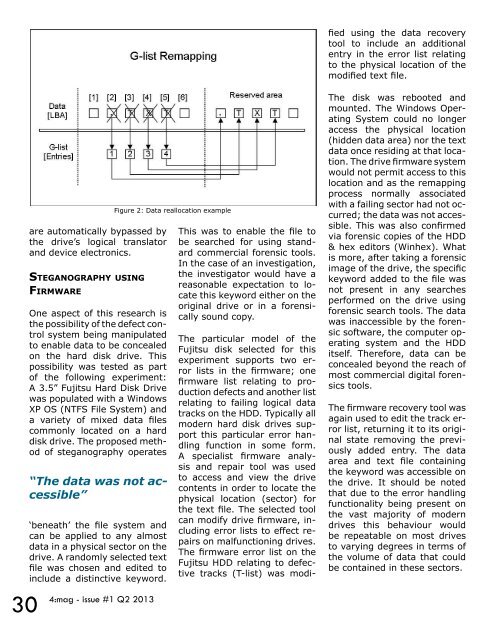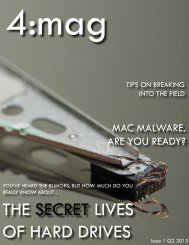Create successful ePaper yourself
Turn your PDF publications into a flip-book with our unique Google optimized e-Paper software.
30<br />
are automatically bypassed by<br />
the drive’s logical translator<br />
and device electronics.<br />
stegAnogrAphy using<br />
FirMwAre<br />
One aspect of this research is<br />
the possibility of the defect control<br />
system being manipulated<br />
to enable data to be concealed<br />
on the hard disk drive. This<br />
possibility was tested as part<br />
of the following experiment:<br />
A 3.5” Fujitsu Hard Disk Drive<br />
was populated with a Windows<br />
XP OS (NTFS File System) and<br />
a variety of mixed data files<br />
commonly located on a hard<br />
disk drive. The proposed method<br />
of steganography operates<br />
“The data was not accessible”<br />
‘beneath’ the file system and<br />
can be applied to any almost<br />
data in a physical sector on the<br />
drive. A randomly selected text<br />
file was chosen and edited to<br />
include a distinctive keyword.<br />
4:<strong>mag</strong> - issue <strong>#1</strong> <strong>Q2</strong> <strong>2013</strong><br />
Figure 2: Data reallocation example<br />
This was to enable the file to<br />
be searched for using standard<br />
commercial forensic tools.<br />
In the case of an investigation,<br />
the investigator would have a<br />
reasonable expectation to locate<br />
this keyword either on the<br />
original drive or in a forensically<br />
sound copy.<br />
The particular model of the<br />
Fujitsu disk selected for this<br />
experiment supports two error<br />
lists in the firmware; one<br />
firmware list relating to production<br />
defects and another list<br />
relating to failing logical data<br />
tracks on the HDD. Typically all<br />
modern hard disk drives support<br />
this particular error handling<br />
function in some form.<br />
A specialist firmware analysis<br />
and repair tool was used<br />
to access and view the drive<br />
contents in order to locate the<br />
physical location (sector) for<br />
the text file. The selected tool<br />
can modify drive firmware, including<br />
error lists to effect repairs<br />
on malfunctioning drives.<br />
The firmware error list on the<br />
Fujitsu HDD relating to defective<br />
tracks (T-list) was modi-<br />
fied using the data recovery<br />
tool to include an additional<br />
entry in the error list relating<br />
to the physical location of the<br />
modified text file.<br />
The disk was rebooted and<br />
mounted. The Windows Operating<br />
System could no longer<br />
access the physical location<br />
(hidden data area) nor the text<br />
data once residing at that location.<br />
The drive firmware system<br />
would not permit access to this<br />
location and as the remapping<br />
process normally associated<br />
with a failing sector had not occurred;<br />
the data was not accessible.<br />
This was also confirmed<br />
via forensic copies of the HDD<br />
& hex editors (Winhex). What<br />
is more, after taking a forensic<br />
i<strong>mag</strong>e of the drive, the specific<br />
keyword added to the file was<br />
not present in any searches<br />
performed on the drive using<br />
forensic search tools. The data<br />
was inaccessible by the forensic<br />
software, the computer operating<br />
system and the HDD<br />
itself. Therefore, data can be<br />
concealed beyond the reach of<br />
most commercial digital forensics<br />
tools.<br />
The firmware recovery tool was<br />
again used to edit the track error<br />
list, returning it to its original<br />
state removing the previously<br />
added entry. The data<br />
area and text file containing<br />
the keyword was accessible on<br />
the drive. It should be noted<br />
that due to the error handling<br />
functionality being present on<br />
the vast majority of modern<br />
drives this behaviour would<br />
be repeatable on most drives<br />
to varying degrees in terms of<br />
the volume of data that could<br />
be contained in these sectors.




